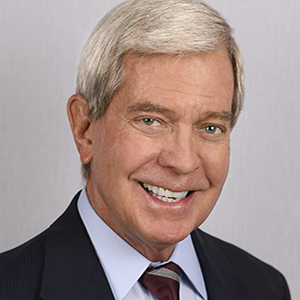Many of you see economic news daily and wonder what to make of what you see. We all hoped 2023 would be a calmer year than 2022, yet we are inundated with stories about banks going under, rising interest rates, and inflation—so far, 2023 remains a bit overwhelming. I will share a few thoughts on some of today’s most significant events and hopefully help you put what you see into perspective.
Some of the most-discussed front-page stories today are about the banking system. Are banks in trouble again? We all remember the S&L failures and bank bailouts of the early 1980s. I forwarded an article on March 21 from Larry Adam, the Chief Investment Officer from Raymond James, to share his perspective on the bank landscape. Although some banks have legitimate problems, much of what you read about is a situational headwind. As the saying goes, when you slam on the brakes, someone will fly through the windshield. Recently, two banks failed—Silicon Valley Bank and Signature Bank.
As concern started to spread, lack of confidence put other banks (i.e., First Republic Bank) at risk. When dominoes fall so quickly, it can create systemic concern, but it also creates opportunity. The only “bailouts” being discussed so far are offers by banking competitors and other investors who see the potential to make money on those banks facing short-term liquidity challenges. Famed investor Warren Buffett made billions investing in the troubled Bank of America in 2011, and he may be joining others in coming to the table to shore up struggling banks again. There are tremendous opportunities for those with cash when times like these arise.
What is driving today’s banking troubles? As you know, the Fed is trying to curb inflation very quickly by raising interest rates – borrowing costs have increased from near zero to over 4.5% to date. Before rates rose, those banks took in customer deposits, then invested those deposits in long-term bonds. When interest rates jumped, new bonds offered a higher coupon rate than older bonds, so the value of older bonds fell. When depositors began withdrawing their funds, the banks sold the discounted bonds at a loss. As investors heard about potential shortages, their panic fueled additional withdrawals, depleting available cash and compounding the problem. Selling devalued assets to raise cash has put those banks in a difficult situation.
Aside from banking headlines, we continue to see market volatility, primarily driven by inflation and high interest rates. High rates not only drive down the value of existing bonds but also slow the growth of the companies that drive our economy, and that slowdown impacts stocks. We’d all like to forget 2022. All major market indices were down, with most being down by double digits. For example, the S&P 500 ended 2022 at 3,839.50 points (down 18% for the year), the Dow Jones Industrial Average ended at 33,147.25 points (down 8.8% for the year), the MSCI EAFE index ended 2022 at 1,943.92 points (down 14.45% on the year). Fixed income products also suffered, with the Bloomberg U.S. Aggregate Bond Index ending the year down 13% and the Morningstar U.S. Core Bond Index losing 12.9%, its most significant annual loss since 1999.
Historically, you do not see fixed income products (i.e., bonds) and equities falling simultaneously because equity and bond performance drivers differ. Bonds typically stabilize a portfolio when equities are struggling. I think most, but not all, of these same indices will end 2023 in positive territory.
“Aside from banking headlines, we continue to see market volatility, primarily driven by inflation and high interest rates.”
Most everyone reading this letter has a good understanding of the many causes of recent high inflation levels. The problem today, in my opinion, is a direct result of delayed Fed action. They did not initially recognize what was happening, calling inflation “transitory” (i.e., short term.) Well, guess what? They were wrong, and it was one of the biggest mistakes in Federal Reserve history. Once they realized their error and set out to bring inflation under control, they were behind the curve and had to raise interest rates faster than at any other time in Fed history.
The Federal Reserve’s long-term goal for inflation is 2%, and today’s objective is to get inflation back down to 2%. Higher interest rates should cause a decline in liquidity, leading to reduced inflation. There is much debate on how quickly this will happen, but the Fed has been very transparent – they have not abandoned their 2% objective. In recent testimony before the Senate Banking Committee, Federal Reserve Chair Jerome H. Powell said “The process of getting inflation back down to 2 percent has a long way to go and is likely going to be bumpy. The latest economic data have come in stronger than expected, which suggests that the ultimate level of interest rates is likely to be higher than previously anticipated.” Hopefully, inflation will be controlled sometime soon. Still, questions remain: When will demand be dampened, and more importantly, how high will interest rates need to rise to bring inflation down?
There is much debate today on whether interest rate increases are working. Most experts agree it takes about a year before rate hike results are reflected in the economy. The current round of rate increases began in March 2022, so it has barely been one year. This delayed impact is known as “the lag effect,” and it is real.
We have already seen some impact from higher rates, especially in the housing market. The housing market was on fire and needed to be cooled off. Housing prices have dropped, and listings stay on the market longer. The degree of impact varies significantly depending on geographical location. The DFW metroplex has held up relatively well, which is to be expected as people continue to migrate to Texas from other higher-cost states. A slowdown in the housing market impacts related industries more gradually. For example, when housing purchases slow, there isn’t as much spending on new furniture, appliances, fencing, etc. We saw the opposite effect when interest rates declined a few years ago, fueling housing starts. As sales slow in these housing-related markets, it may drive down the stock prices of those impacted companies but should certainly dampen inflation.
I do, however, believe inflation has peaked, but the Federal Reserve raised rates another 25 basis points last month. Trying to predict future actions by the Federal Reserve is a loser’s game, but I do not think they are through raising rates for two reasons. One, they have stated on several occasions that they want to ensure inflation is under control. The second reason is fear of repeating a mistake made by Paul Volcker years ago.
By the time Volcker became Fed chair in July 1979, the central bank’s credibility on inflation had been destroyed by the disastrous policies of the previous chairs, Arthur Burns and G William Miller, with inflation climbing to more than 12% by October 1979. At a surprise press conference on October 6, 1979, Volcker announced that the Fed would allow the benchmark federal funds rate to “fluctuate over a wider range.” The federal funds rate climbed to more than 17% by April 1980.
Pressure on the Fed to reverse these rate increases began to build, with farmers blockading the Fed headquarters in Washington with their tractors and car dealers sending car keys in little coffins to the Fed. Politicians of both parties then piled on and strongly urged the Fed to scale back interest rates. With the unemployment rate rising by more than a percentage point, action was taken even though inflation reached a peak of 14.7% in April 1980. The Fed had blinked and Volcker’s credibility as an inflation fighter took a hit. Inflation expectations stayed stubbornly high and actual inflation remained above 12% through the end of the year. (Financial Times – “The Fed must avoid Volcker’s inflation error;” Frederic Mishkin Markets Insight)
“I expect equity markets to reflect higher returns by the end of this year, but I am not sure we will see double digit returns.”
An area that most concerns the Fed today is wage inflation. You may remember, in my white paper last year, I mentioned how much this concerned me. There were many people in our population whose salaries did not keep up with inflation during the COVID crisis. Consequently, some wage increase was necessary and is not bad in the long term—it’s part of returning to normalcy. With tech layoffs continuing, wage inflation will slowly come under control. I recently attended a conference in Colorado where the speaker pointed out that most job increases today are in the lower income brackets, such as servers and retail employees.
Please keep in mind it was only about two weeks ago when the Fed discussed raising rates by another 50 basis points. Their dilemma is balancing the need to cool down inflation without fueling a banking fire. We discussed several failures above, and there is no doubt that high-interest rates contributed to the troubles of both these banking institutions. Let me be clear; the biggest culprit in the failure of those banks, without question, was poor corporate management.
There does not appear to be a widespread banking problem; it seems isolated to poorly run regional banks. Silicon Valley Bank’s failure does not compare with the previous collapse of Lehman Brothers. But experience has taught me that I do not know what I do not know. As I have said many times, it is not what I see that concerns me; it is what I cannot see.
I wonder what other issues have come “out of left field” that should have been anticipated. Over the next few weeks, all of this will either be over and done with, or the Fed will be dealing with a much more significant problem.
We have experienced a tough start to 2023 in an environment where markets struggle to rebound. I believe over the next two or three months, inflation will become more controlled, resulting in the Fed holding less steady on rates than they initially anticipated. I would not be surprised if we saw interest rates begin to decrease by the fourth quarter 2023, and no later than first quarter 2024. I expect equity markets to reflect higher returns by the end of this year, but I am not sure we will see double-digit returns.
Everything that has happened with rising interest rates has been transformative. I say this because, for the first time in nearly 20 years, fixed income is an excellent place to invest money. Fixed income is not for growth, but we have always recommended investing in this area to help stabilize financial portfolios during market volatility. Additionally, investments in cash accounts (i.e., CDs or money markets) can finally produce decent returns. I
In summary, we will send out additional communications if anything significant happens. The conversation may soon change from inflation and banking to the debt ceiling. Stay tuned.
The foregoing information has been obtained from sources considered to be reliable, but we do not guarantee that it is accurate or complete, it is not a statement of all available data necessary for making an investment decision, and it does not constitute a recommendation. Any opinions are those of Bill E Carter and not necessarily those of Raymond James. Every investor’s situation is unique, and you should consider your investment goals, risk tolerance and time horizon before making any investment. Prior to making an investment decision, please consult with your financial advisor about your individual situation. Bond prices and yields are subject to change based upon market conditions and availability. If bonds are sold prior to maturity, you may receive more or less than your initial investment. There is an inverse relationship between interest rate movements and fixed income prices. Generally, when interest rates rise, fixed income prices fall and when interest rates fall, fixed income prices rise. There is no guarantee that these statements, opinions, or forecasts provided herein will prove to be correct. An investment in a money market fund is neither insured nor guaranteed by the FDIC or any other government agency.
Although the fund seeks to preserve the value of your investment at $1.00 per share, it is possible to lose money by investing in the fund. Investors should consider the investment objective, risks, charges, and expenses carefully before investing. The prospectus, which contains this and other important information, is available from your Financial Advisor and should be read carefully before investing. CDs are insured by the FDIC and offer a fixed rate of return, whereas the return and principal value of investment securities fluctuate with changes in market conditions. You cannot invest directly in any index and past performance doesn’t guarantee future results.

Bill Carter founded Carter Financial Management in 1976. The firm has grown to include a full suite of experienced financial planning professionals managing over $1 billion in assets. Dedicated to client service and professional excellence, Bill puts his deep knowledge of tax, investment and estate planning to work in helping clients define and reach their financial and life goals.


 Linkedin
Linkedin Facebook
Facebook Twitter
Twitter Youtube
Youtube


